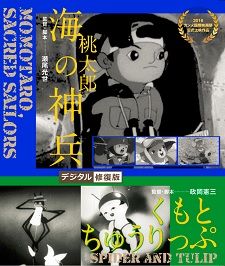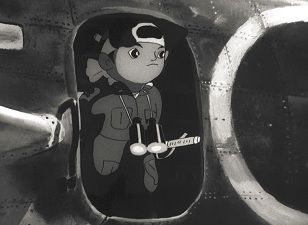Japan's First Feature-Length Animation Restored Digitally for Blu-ray Release
May 25, 2016 4:26 AM (PDT) by arsonal | Forum Discussion
 Earlier this month at the 2016 Cannes Film Festival, film distributor Shochiku held a public screening of Momotarou: Umi no Shinpei (Momotaro, Sacred Sailors), a 1945 war propaganda film considered to be Japan's first feature-length animation work. It was the first public screening of the film's digital restoration, which was completed by Imagica.
Earlier this month at the 2016 Cannes Film Festival, film distributor Shochiku held a public screening of Momotarou: Umi no Shinpei (Momotaro, Sacred Sailors), a 1945 war propaganda film considered to be Japan's first feature-length animation work. It was the first public screening of the film's digital restoration, which was completed by Imagica.The project was launched in 2015 to commemorate Shochiku's 120th anniversary. In order to conduct the restoration, Imagica scanned the master positives of the film in 4K resolution before being projected to 2K resolution when the repairs were completed. Any scratches, dirt, flicker, and torn or missing segments were repaired by hand.
Cinematographer Masashi Chikamori, a three-time Japan Academy Prize nominee, and Atsushi Okui, director of photography for Studio Ghibli's Kaze Tachinu, led the restoration project. California-based Audio Mechanics, which previously worked on the digital preservation of 20th Century Fox's feature film sound assets, provided assistance with Momotarou: Umi no Shinpei's sound restoration.
Momotarou: Umi no Shinpei will be packaged on Blu-ray and DVD along with a digitally restored edition of another Shochiku animation, Kumo to Tulip (The Spider and the Tulip). They will go on sale on August 3, 2016.
Where Japan's feature-length animation began
In April 1943, as the war between Japanese and Allied naval forces in the Pacific reached a turning point, animators at the Shochiku production house began planning what would become Japan's first feature-length animation film.
Earlier that year, Shochiku had completed work on Kumo to Tulip, which tells the story of a spider trying to trap a ladybug. Its director Kenzou Masaoka was among the first to use cel animation as the primary method of production, and Kumo to Tulip was the first work to be made entirely using cel animation. Masaoka's work went on to influence the next generation of animators such as Leiji Matsumoto and Osamu Tezuka.
Shochiku had established its animation division, the Shochiku Animation Institute, in May 1941 to capitalize on the boom of "cartoon films." When the Pacific war broke out several months later, the Imperial Navy instructed it to shift production to works promoting national policy. Shochiku received a funding of 270,000 yen to produce a new work related to the propaganda film Momotarou no Umiwashi (Momotaro's Sea Eagles), which features the popular folktale hero Momotarou supporting the navy's war effort.
Mitsuyo Seo, who directed Momotarou no Umiwashi, joined Shochiku in 1942 and led production on the new work titled Momotarou: Umi no Shinpei. The naval ministry wanted Seo to take inspiration from Walt Disney's 1940 film Fantasia with the objective of providing children with hopes and dreams and a sense of purpose.
Production in a time of war
 Shochiku's team of animators worked out of a studio location next to Tokyo's Ginza district, with luxurious facilities unthinkable in the industry today. However, as the war took a turn for the worse for Japan, the original team of 70 animators dwindled to 15 by the end of the production as young men were being drafted into the thinning ranks of the military.
Shochiku's team of animators worked out of a studio location next to Tokyo's Ginza district, with luxurious facilities unthinkable in the industry today. However, as the war took a turn for the worse for Japan, the original team of 70 animators dwindled to 15 by the end of the production as young men were being drafted into the thinning ranks of the military.Working in the center of Tokyo also meant that the studio location was under constant threat of American air raids. Every time the air raid sirens blared across the city, the production team must secure all production materials and take them underground into the city's bomb shelters. Shortage of materials was also common, and cels were sometimes reused by washing off old hand-drawn paint.
Production of Momotarou: Umi no Shinpei was completed in December 1944, but edits requested by the naval ministry postponed the first screening until the spring of 1945. When the war ended several months later, the film was thought to be lost as Allied forces confiscated all propaganda material. Negatives were later discovered in a Shochiku warehouse in 1982, and the film was finally released on VHS in 1984.
Source: Festival de Cannes, Anime! Anime!, Eiga Natalie
Related Database Entries
Related News
- Q2 2016 Anime & Manga Licenses [Update 6/15] AMP
- Mar 31, 2016 12:20 PM (PDT) by Snow
- North American Anime & Manga Releases for May AMP
- May 1, 2017 10:58 AM (PDT) by Sakana-san
- 'Girls & Panzer: Saishuushou' 3rd Movie Blu-ray and DVD Bundles OVA AMP
- Aug 26, 2021 11:42 PM (PDT) by Vindstot
- Q3 2014 Anime Licenses [Update 9/28] AMP
- Jul 4, 2014 1:51 PM (PDT) by Dunois
- 'Classroom☆Crisis' to Include Bundled Special AMP
- Aug 29, 2015 3:08 PM (PDT) by Sakana-san